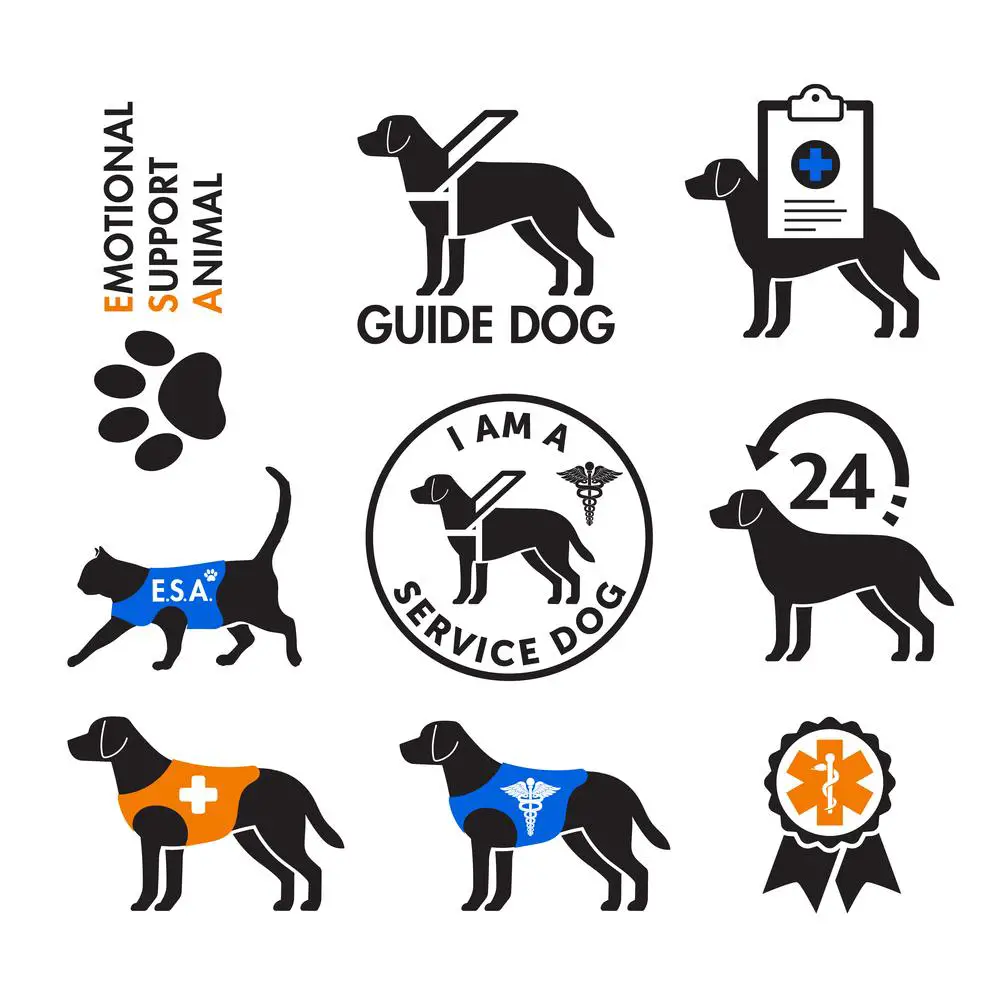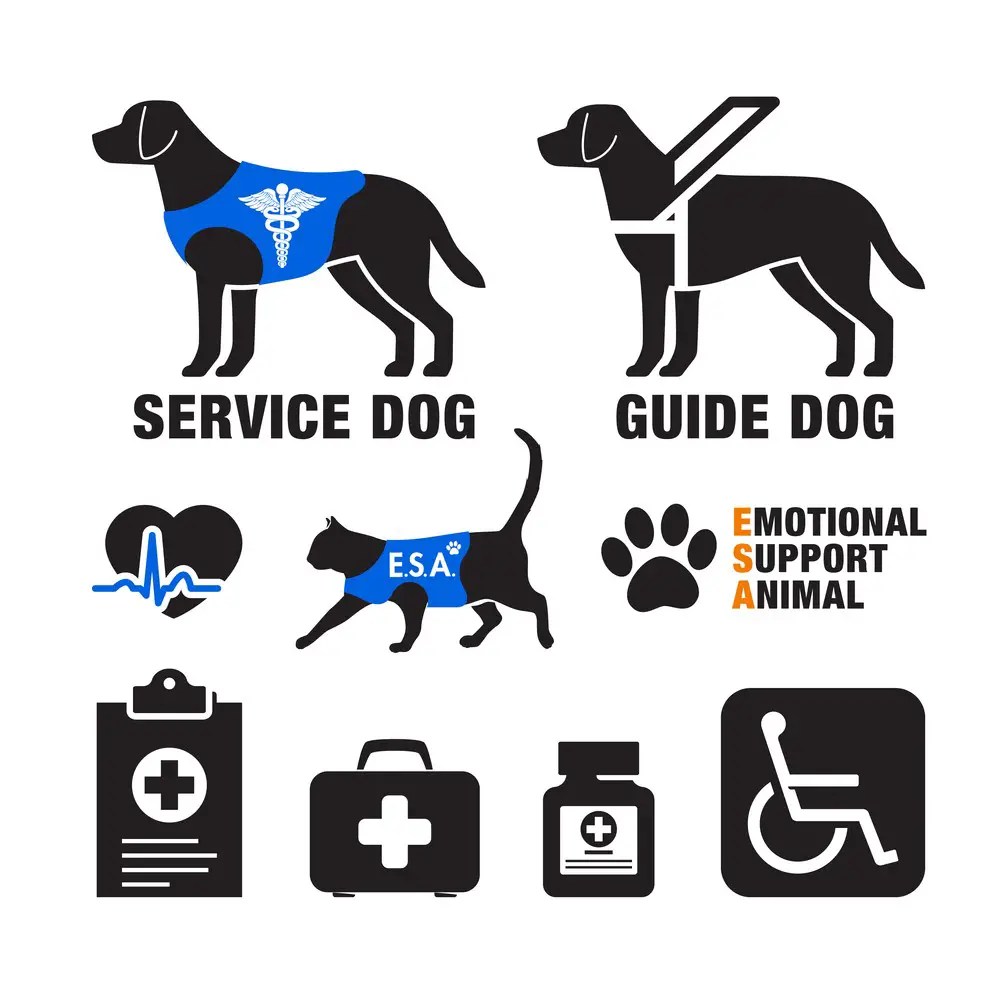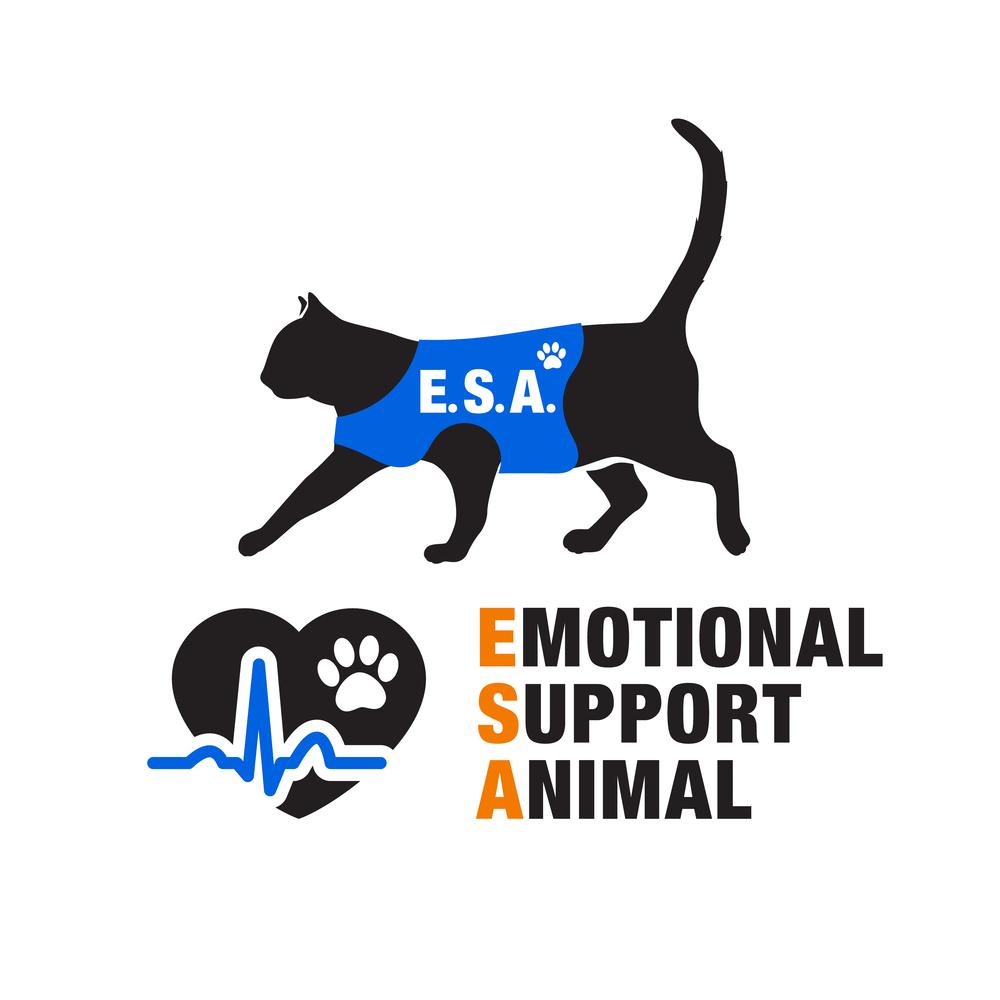As a BetterHelp affiliate, we receive compensation from BetterHelp if you purchase products or services through the links provided
Emotional support dogs are a crucial component of mental health management strategies for many people. These remarkable animals provide people dealing with various emotional and psychological challenges with comfort and reassurance.
When someone requires hospitalization, emotional support dogs can be an indispensable source of comfort. However, it is important to note that the rules regarding whether these animals are permitted in hospitals are not always straightforward and can vary depending on location and institution.
The role of emotional support animals is acknowledged in various legal frameworks that dictate how they are accommodated in public places, including hospitals. Access and restrictions depend on several factors, such as individual hospital policies and the necessary documentation proving the animal’s status. Understanding the balance between a patient’s needs for emotional support and the operational considerations of a healthcare setting is essential for both patients and healthcare providers.
It’s beneficial to be clear on the difference between emotional support dogs and therapy animals since their hospital access rights differ significantly. At the same time, therapy animals are often part of structured clinical programs, and emotional support dogs typically serve an individual’s mental health needs without specific training for therapeutic intervention. Recognizing the nuances in these definitions can help when deciding to bring support animals into healthcare environments.
Key Takeaways
- Emotional support dogs help individuals manage mental health, but hospital policies on ESA (Emotional Support Animal) access vary.
- Legal and documentation requirements must be met for an emotional support dog to accompany a patient in a hospital.
- Distinguishing between emotional support dogs and therapy animals is key to understanding their respective access to healthcare settings.
The Role of Emotional Support Animals

Emotional Support Animals (ESAs) play a critical part in the well-being of individuals with mental health concerns, offering comfort and a calming presence.
Differences Between ESAs and Service Animals
- Definition: Service animals are specially trained to perform tasks for individuals with disabilities, such as guiding the visually impaired. ESAs, on the other hand, provide companionship and emotional stability.
- Training: Service animals go through rigorous training to assist with disabilities. Emotional support animals require no specific training.
- Legal Recognition: Service animals are legally recognized and protected under the Americans with Disabilities Act (ADA), granting them access to most public areas. ESAs do not have the same level of access.
Key Takeaway: While ESAs offer comfort, they are distinct from service animals and lack the same access rights.
Mental Health Benefits of Emotional Support Animals
- Emotional Stability: Providing comfort and reducing loneliness, ESAs can help steady your emotional state.
- Stress Reduction: Interacting with ESAs can lower stress levels, making it easier to navigate day-to-day challenges.
- Sense of Security: An ESA can offer safety, crucial for those with certain mental health conditions.
Key Takeaway: Your ESA can be a real game-changer in managing stress and enhancing your mental wellness.
Legal Framework Governing ESAs in Hospitals

When navigating the complex world of emotional support animals (ESAs) in hospitals, understanding the legal aspects is crucial. Here’s a clear rundown of federal laws and state regulations that shape your rights and responsibilities.
Americans with Disabilities Act (ADA)
The ADA doesn’t recognize emotional support animals as service animals. This distinction means that the broad accessibility rights granted to service animals—like those that assist individuals who are blind—do not apply to ESAs. Hospitals follow this federal law by not allowing ESAs in sterile environments such as operating rooms. But there’s a flip side: hospitals can choose to allow ESAs in certain areas individually.
Key Takeaway: ESAs don’t have automatic access under the ADA, but permission can vary by hospital.
Fair Housing Act and Air Carrier Access Act
The Fair Housing Act ensures you can live with your ESA no matter the housing policies. The Air Carrier Access Act previously allowed ESAs to travel in the cabin with their owners, although recent changes have tightened regulations, focusing on trained service dogs instead. While these laws don’t govern hospitals directly, understanding them helps you see the bigger picture, wherein ESAs find federal law protection. Hospitals might refer to these acts in shaping their policies.
Key Takeaway: Federal protections exist for ESAs in housing and air travel, which can influence hospital ESA policies.
State-Specific Regulations
Your state might have laws that affect ESA access to hospitals. For example, some states have broader definitions that might allow ESAs more access than federal laws dictate. You must check your state’s laws to know exactly what’s permissible.
- New York: Specific protections for ESAs in housing and employment.
- California: ESAs have some public access rights, depending on the establishment.
Consulting with local legal experts or disability rights organizations can provide tailored guidance.
Key Takeaway: State laws can expand ESA rights, so verifying what your state says about ESAs in hospitals is crucial.
Access and Restrictions for ESAs in Healthcare Settings
When considering bringing an emotional support dog into a hospital, it’s vital to understand access rights and restrictions. Balancing the therapeutic benefits with safety and regulatory concerns is critical.
Hospital Policies on ESAs
Each hospital has its own set of policies regarding emotional support animals (ESAs). These are often shaped by:
- The hospital’s mission and values
- Legal requirements
- Consideration for all patients and staff
Before you visit, contacting the hospital’s administration is critical to confirm their specific rules. Some may require:
- Proof of the dog’s health and vaccination status
- A letter from a licensed mental health professional
Key takeaway: Always check and adhere to a hospital’s policies for ESAs.
Patient Safety and Infection Control
Your emotional support dog must not compromise health standards. Hospitals put these practices in place to protect everyone:
- Routine cleanliness checks
- Health screenings for ESAs
They also set areas where ESAs are restricted due to high infection risks, such as:
- Intensive Care Units (ICUs)
- Operating rooms
Key takeaway: ESAs are welcome where they don’t risk patient safety and adhere to infection control standards.
Rights of Other Patients and Staff
Your right to bring an emotional support dog is balanced against the rights of others in the hospital. Consider this:
- Allergies: Some staff or patients may be allergic to animals.
- Phobias: The presence of dogs can be a source of additional stress for others.
Hospitals may designate specific areas or times for ESAs to avoid conflicts.
Key takeaway: Be aware of the impact of your ESA on others and respect the guidelines provided by the hospital.
Understanding Documentation for Emotional Support Dogs
 The proper paperwork is crucial when bringing an emotional support dog (ESA) into a hospital. This ensures your companion can stay by your side, providing comfort and support when needed.
The proper paperwork is crucial when bringing an emotional support dog (ESA) into a hospital. This ensures your companion can stay by your side, providing comfort and support when needed.
Required Proof for ESAs
To have your emotional support dog with you in a hospital, you need valid documentation. Here’s what you typically must show:
- Identification of the ESA: This usually includes a photo, name, and confirmation that the animal is your ESA.
- Letter from a Licensed Mental Health Professional: A recently signed (usually within the year) and dated letter on a professional letterhead is critical.
Key Takeaway: Always keep your ESA’s documentation updated and easily accessible.
Verification from Mental Health Professionals
A licensed mental health professional—like a psychiatrist, psychologist, or clinical social worker—must verify your need for an emotional support dog. Their letter should include:
- Your Mental Health: It must state that you have a mental health condition for which the ESA provides support.
- Professional’s License: Information such as license type, the date the license was issued, and the state that gave it.
Key Takeaway: Ensure the verification comes from a professional caring for your mental health needs.
Best Practices for Bringing ESAs to Public Places
Understanding the proper etiquette for emotional support dogs in public opens doors for you and your furry friend. Here’s what you need to stay mindful about.
Behavior and Training Guidelines
Your emotional support dog should have basic training to be calm and obedient in public settings. Here’s what to aim for:
- Behavior:
- Keep your dog on a leash unless it is unnecessary for their support role.
- Ensure they do not jump on or bark at strangers.
- Training:
- Train your dog to respond to basic commands like “sit,” “stay,” and “come.”
Remember, everyone appreciates a well-behaved dog, making your experience stress-free and more welcoming.
Public Access with ESAs
Navigating public access requires knowing your rights and responsibilities:
- Right to Access:
- Know that ESAs are not afforded the same access as service animals under the ADA.
- Responsibilities:
- Carry proof of your ESA’s status if required.
- Always respect private property rules regarding ESAs.
You ensure a smooth outing with your emotional support dog by staying informed.
Key Takeaway: Stick to these practices to help your ESA be a positive presence in public spaces.
The Importance of Responsible ESA Ownership
When you have an emotional support dog (ESA), it’s essential to understand the responsibilities that come with ownership to ensure the well-being of both your ESA and the public.
Caring for Your Emotional Support Dog
Your emotional support dog relies on you for its health and happiness. Here are some critical strategies for proper care:
- Routine Health Check-ups: Regular visits to the vet ensure your ESA stays up to date with vaccinations and maintains overall health.
- Balanced Diet: Feed your dog a nutritious diet for age, weight, and specific needs.
- Exercise: Daily exercise is vital for your ESA’s physical and mental well-being.
- Grooming: Keep up with grooming tasks such as brushing teeth, clipping nails, and coat care, fostering comfort and good hygiene.
Key Takeaway: A well-cared-for emotional support dog is likelier to exhibit calm and stable behavior, which is crucial in public settings.
Ensuring Your ESA Is Well-Behaved in Public
To be a considerate handler, it’s crucial to ensure your ESA demonstrates good behavior in public. Here’s how you can help your ESA to be well-mannered:
- Basic Training: Teach your ESA basic commands like sit, stay, come, and down. Training promotes good behavior and the safety of your ESA and those around it.
- Socialization: Gradually expose your emotional support dog to different people, environments, and other animals to foster adaptability and reduce anxiety or aggressive responses.
- Understanding ESA Guidelines: Familiarize yourself with legal regulations and individual venues’ policies regarding emotional support animals to avoid conflicts.
Key Takeaway: An emotional support dog that is well-behaved in public reflects positively on you as the handler and is more likely to be welcomed in various settings.
Difference Between ESAs and Therapy Animals
 Before diving into the roles and benefits of therapy dogs, it’s vital to understand the clear distinctions between Emotional Support Animals (ESAs) and therapy animals. While they might seem similar, their purposes, training, and the rights they’re granted differ significantly.
Before diving into the roles and benefits of therapy dogs, it’s vital to understand the clear distinctions between Emotional Support Animals (ESAs) and therapy animals. While they might seem similar, their purposes, training, and the rights they’re granted differ significantly.
Benefits and Usage of Therapy Dogs
Therapy Dogs are trained to provide comfort and relief to multiple people in hospitals, schools, and nursing homes. They are typically owned by individuals who take them to visit various facilities. These dogs have a special knack for interacting with people therapeutically.
- Tasks Therapy Dogs Perform:
- Reduce stress in patients through physical contact, like cuddling
- Encourage communication in individuals who are withdrawn or non-communicative
- Provide specific therapeutic contacts under the guidance of healthcare professionals
On the other hand, emotional Support Animals (ESAs) are not trained for public interaction. Instead, their primary role is to offer companionship and emotional stability to a specific individual with a psychological or emotional condition. They do not necessarily perform tasks, but their presence is a consistent comfort to their owner.
- Differences to keep in mind:
- Training: Therapy dogs receive training to interact with many individuals; ESAs do not.
- Certification: Therapy dogs are tested and certified; ESAs require a letter from a healthcare professional.
- Legal Rights: Therapy dogs have access to public places for therapeutic work; ESAs have housing and air travel rights, but public access is limited.
Remember, when considering a therapy dog visit or getting an ESA, it’s essential to understand these roles. This ensures the right fit for your needs and helps maintain the integrity of animal-assisted support.
Accommodating ESAs in Non-Hospital Settings
When you’re out and about, navigating everyday spaces with your emotional support animal (ESA), the experience differs significantly from hospitals. Knowing the ins and outs can smooth the path for you and your animal companion.
ESAs in Restaurants and Hotels
Restaurants and hotels are places where everyone looks to enjoy comfort, but policies regarding emotional support animals can vary. Here’s the scoop:
- Restaurants:
- Health regulations: Usually, restaurants must follow strict health codes that do not allow animals.
- Business discretion: Some establishments may make exceptions for ESAs under their policies, so it’s worth asking in advance.
- Hotels:
- ESA policies: Many hotels have specific policies for ESAs, separate from those for pets.
- Extra fees: Watch for potential additional charges or restrictions on types or sizes of animals allowed.
Key takeaway: Before stepping out, quickly call or check online to ensure your ESA can be accommodated to avoid surprises.
Bringing ESAs into Workplaces and Schools

Workplaces and schools can be more complex due to varying regulations and individual needs. Let’s break it down:
- Workplaces:
- Individual company policy: Companies can decide their rules regarding ESAs.
- Request accommodations: It’s best to discuss your needs with human resources for a tailored approach.
- Schools:
- Disability services: Schools often have offices or services dedicated to disability accommodations, where ESA allowances can be discussed.
- Case-by-case basis: Each case is usually reviewed individually to determine the appropriateness of an ESA on campus.
Remember to communicate clearly with relevant authorities in your workplace or school; providing the documentation for your ESA can pave the way for a more supportive environment.
Key takeaway: Open dialogue and preparedness are your best tools for integrating your ESA into everyday work and learning environments.
Understanding Breed and Size Restrictions
When considering bringing an emotional support dog (ESA) into a hospital, it’s crucial to understand that specific breed and size restrictions may apply. These guidelines are in place to ensure the safety and well-being of patients, staff, and the animals themselves.
Common Misconceptions About ESA Breeds
Many believe any breed can qualify as an emotional support dog, but this isn’t always the case, especially in a hospital environment. Here’s a breakdown to clarify these common misunderstandings:
- Breed Restrictions: Some hospitals may restrict certain breeds from entering due to perceived temperament or aggression issues. It’s essential to check the hospital’s policy beforehand.
- Size Considerations: While size alone doesn’t disqualify an ESA, larger dogs might face more restrictions due to space and maneuverability in hospital settings.
Key Takeaway: Before visiting a hospital, check their policies regarding ESA breeds and sizes to ensure compliance and avoid complications.
Encounters with Emotional Support Dogs: Etiquette and Best Practices
Emotional support dogs offer comfort and support in ways only animals can. However, recognizing the correct etiquette when encountering them in hospitals is vital for maintaining their effectiveness and respecting their owners.
How to Approach Someone with an ESA
When you see someone with an emotional support dog, it’s important to remember that although these dogs provide comfort, they’re not pets in the traditional sense. They’re a critical part of their owner’s well-being. Here’s what to do:
- Ask for Permission: Before approaching or petting the dog, ask the owner for permission. It shows respect for their space and needs.
- Be Calm and Quiet: Keep your voice down and avoid sudden movements that could startle the dog.
Key takeaway: Always seek consent from the owner when approaching an emotional support dog, respecting their role in the owner’s health.
Avoid Disrupting Service Dogs and ESAs
Service dogs and emotional support animals are working animals, not for your entertainment. Interacting with them improperly can disrupt their essential tasks. Keep these tips in mind:
- Do Not Distract: Avoid calling out, whistling, or doing anything that could divert the dog’s attention from their task.
- Maintain Distance: Steer clear of touching a service dog or the emotional support animal without permission as they’re focusing on their handler.
Key takeaway: Remember not to disrupt service dogs and emotional support animals, as they are performing critical support roles.
Frequently Asked Questions
Navigating hospital visits with an emotional support dog can be complex, as rules vary by location and situation. Here’s what you need to know about your fuzzy companion’s access to healthcare settings.
What distinguishes emotional support dogs from service dogs?
Emotional support dogs comfort their owners through companionship and affection without specialized training. Service dogs, however, are trained to perform tasks directly related to an individual’s disability.
Key Takeaway: Service dogs have specialized training for specific tasks, while emotional support dogs offer general comfort.
What are the guidelines for emotional support animals in public places like restaurants and stores?
Generally, emotional support animals do not have the same legal access rights as service animals. Businesses like restaurants and stores may choose to allow them, but are not required by the Americans with Disabilities Act (ADA).
Key Takeaway: Access to emotional support animals in public businesses is discretionary, unlike service animals.
Can hospitals deny access to emotional support dogs?
Hospitals can restrict access to emotional support dogs due to health and safety regulations, particularly in sterile environments. However, it’s always worth contacting the hospital in advance as some may grant permission on a case-by-case basis.
Key Takeaway: Hospital policies on emotional support dogs vary, so it’s best to check ahead.
What documentation might be required to prove my dog is a legitimate emotional support animal?
You may be asked to provide a letter from a licensed mental health professional stating your need for an emotional support animal. Be prepared to show this documentation to verify the role of your dog.
Key Takeaway: Keep a letter from a mental health professional handy to validate your emotional support dog.
How do state laws differ regarding the presence of emotional support dogs in public areas?
State regulations around emotional support dogs vary widely. Some states offer more inclusivity in public places, while others adhere strictly to federal guidelines. It’s crucial to look into your state’s specific laws.
Key Takeaway: Familiarize yourself with your state’s laws on emotional support dogs to avoid surprises.
Are there specific dog breeds that are more commonly recognized as emotional support animals?
No specific breeds are officially recognized over others as emotional support animals. The vital factor is the bond and the alleviation of an individual’s emotional or psychological symptoms.
Key Takeaway: Any dog breed can be an emotional support animal if they provide comfort and support.
- 3 Ways Wearing a Hat Can Help Lower Your Stress Levels - April 19, 2025
- Breaking the Silence: Why Men’s Mental Health Matters More Than Ever - April 15, 2025
- How to Transform a Home’s Patio Space into a Relaxing Space - March 23, 2025
This site contains affiliate links to products. We will receive a commission for purchases made through these links.



